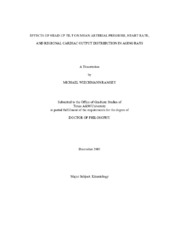| dc.description.abstract | Many senescent individuals demonstrate an inability to regulate mean arterial
pressure (MAP) in response to standing or head-up tilt; however, whether this aging
effect is the result of depressed cardiac function or an inability to reduce peripheral
vascular conductance remains unknown. Therefore, the purpose of this research was to
investigate the effects of aging on MAP, heart rate (HR), regional blood flow (via
radioactive-microspheres), and vascular conductance during head-up tilt in conscious
young (4 mo; n=12) and old (24 mo; n=10) male Fischer-344 rats. Heart rate and MAP
were measured continuously during normal posture and during 10 minutes of head-up
tilt. Blood flow was determined during normal posture and at the end of 10 minutes of
head-up tilt. Young rats increased MAP significantly at the onset of head-up tilt and
generally maintained the increase in MAP for the duration of head-up tilt, while aged
rats showed a significant reduction in MAP after 10 minutes of head-up tilt. In the
normal posture, aged rats demonstrated lower blood flow to splanchnic, bone, renal, and
skin tissues versus young rats. With tilt there were decreases in blood flow to skin, bone, and hind-limb in both age groups and in fat, splanchnic, reproductive, and renal
tissues in the young. Bone blood flow was attenuated with age across both conditions in
hind foot, distal femur, femur marrow, and proximal and distal tibia. Head-up tilt caused
a decrease in blood flow across both age groups in all bones sampled with the exception
of the hind foot. These results provide evidence that the initial maintenance of MAP in
aged rats during head-up tilt occurs through decreased regional blood flow and vascular
conductance, and that the fall in pressure is not attributable to an increase in tissue blood
flow and vascular conductance. Therefore, reductions in arterial pressure during headup
tilt are likely a result of an old age-induced reduction in cardiac performance. In
addition, this is the first study to demonstrate a decreased bone vascular conductance in
both young and old rats during head-up tilt. | en |


